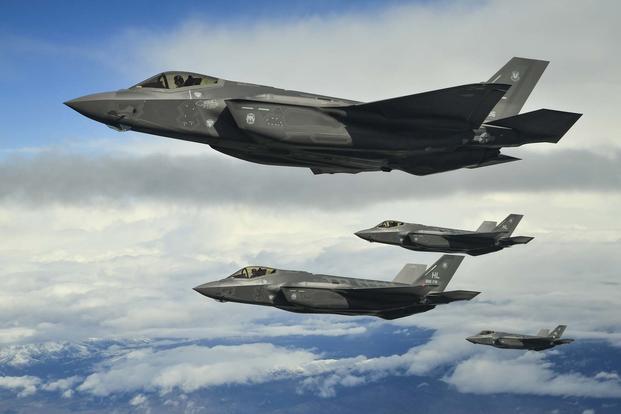Costs for the Defense Department's upgrade to the F-35 Joint Strike Fighter's critical software system have gone nearly $2 billion over estimates during the last two years, according to a new congressional watchdog report. And increased delays signal that the effort is unlikely to meet its deadlines, findings revealed.
The Government Accountability Office said Thursday that the Pentagon's Block 4 program for the stealth fighter has seen a net increase of $1.9 billion in costs since May 2019. New estimates put the total program price for the modernization at roughly $14.4 billion, the report states.
Upgrades to Block 4, the latest software modernization update for the F-35's avionics and weapons delivery, began in 2018. Most notably, Block 4 is meant to expand the type of weapons the aircraft can carry, including Raytheon's Stormbreaker small-diameter bomb.
Read Next: 13-Year-Old Stepson Kills NCO After Watching Him Allegedly Assault His Mother, Police Say
The DoD originally projected Block 4 would be completed by 2026; in 2020, officials added a year to the timeline, citing delays. Even with a new projected timeframe of 2027, the GAO report states that the Joint Program Office, or JPO, which oversees the Joint Strike Fighter program for the Army, Navy and Air Force, "did not formulate its revised schedule based on the contractor's demonstrated past performance."
"The schedule is based on estimates formulated at the start of the Block 4 effort, increasing the likelihood that the scheduled 2027 completion date is not achievable," GAO investigators found.
Responding to the GAO's latest findings, Lockheed Martin, the F-35's manufacturer, said it initiated a "program-wide software assessment" alongside the JPO in 2020. The assessment spurred the creation of an independent review team including Lockheed, JPO, and government and industry representatives, the company said in a statement Thursday.
The team "has made significant progress in identifying and addressing opportunities that provide quality products on time and on budget for the F-35 customer. We understand the importance of these efforts in ensuring the warfighter maximizes the unmatched, combat-proven capabilities of the F-35," Lockheed said.
According to the GAO, part of the cost increase can be attributed to incorporating the latest computing upgrade, known as "Technology Refresh 3," or TR-3. With its suite of interconnected software and hardware technologies, TR-3 provides the aircraft with prompt processing capability and increased memory, among other capabilities, the GAO said.
But because TR-3's development within Block 4 "is more complex than originally thought," its costs have surged by 48% -- or $296 million -- since May 2019, the report states. While much of the TR-3 update will be incorporated in the latest batch of aircraft in 2023, its development is still "tracking 7 months later than originally planned," the report adds.
The extensive, 67-page report noted other setbacks unrelated to Block 4 modernization. In a 2019 study, the GAO found that the F-35 program suffers from lapses in supply chain management for spare parts, falling short of performance and operational requirements. In the new report, the GAO said that issue has been "exacerbated" by delays brought on as a result of the COVID-19 pandemic.
"According to program officials, the contractor does not expect to recover from all of these parts challenges until late 2022," the report states.
There has been progress in finding alternative suppliers for parts made by Turkey, the GAO said. In 2019, the Pentagon officially booted the country from the F-35 program over its purchase of the Russian-made S-400 surface-to-air missile system; as a result, the DoD also began phasing it out of the supply system.
Turkish industries produce roughly 1,000 parts for the F-35, including items for the landing gear and fuselage.
"As of December 2020, the program had identified alternative suppliers for all 1,005 parts," the report states. "The program estimates it will cost $108 million to establish alternative suppliers but has not negotiated these costs with them."
The Pentagon originally estimated it would cost $500 million to $600 million to find new suppliers.
-- Oriana Pawlyk can be reached at oriana.pawlyk@military.com. Follow her on Twitter at @oriana0214.
Related: Watchdog: Pentagon Needs to Answer Questions on New F-35 Logistics System












